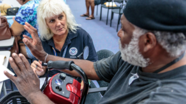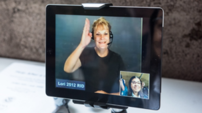
Cultural and Population Sensitivity in Disaster Behavioral Health Programs
The United States grows more racially and ethnically diverse each year. This growth in diversity makes it important for first responders, state planners, and disaster response volunteers to develop strategies to work with people of a variety of races, ethnicities, and cultures. It is also important that disaster planning, response, and recovery include people with access and functional needs, who make up nearly 20 percent of the American population.
This special double issue of The Dialogue from the SAMHSA Disaster Technical Assistance Center (DTAC) highlights the process of working with special populations before, during, and after a disaster as well as building culturally sensitive disaster behavioral health programs. Authors share their experiences working with different cultures, the importance of being culturally sensitive, and the concerns of populations with access and functional needs.
Do you have experience working with diverse or special populations? What lessons have you learned from your efforts? Please email your experiences to us at dtac@samhsa.hhs.gov. We’ll print selected reader comments in a future issue of The Dialogue.
 Issue HighlightsAsk, Respect, Empower—Letting the Community Guide Cultural Sensitivity Culturally sensitive disaster behavioral health programs are important when providing help after a disaster. However, cultural sensitivity does not mean having to know everything about the community’s diversity. Learn what it means to “ask, respect, and empower” when you don’t know about the culture of the population being aided. |
After the Hurricanes: Culturally Appropriate Disaster Behavioral Health in the U.S. Virgin Islands Two mental health professionals in the U.S. Virgin Islands are interviewed and discuss their work on a Crisis Counseling Assistance and Training Program aiding in the recovery efforts after two Category 5 storms. They share their knowledge of island cultures and how to best provide culturally sensitive services. |  |
Cultural Sensitivity in Disaster Preparedness and Response The way individuals react following a disaster is in part shaped by their culture, history, and other sociocultural factors. Learn how cultural sensitivity is an important consideration for disaster preparedness and its role in how individuals cope immediately after a disaster and in their long-term recovery. |  |
Working With Island Populations Island states and nations, such as Hawaii, require a special approach when responding to disasters. Their unique physical features and mixture of cultures bring the need for additional resources after a disaster. Learn more about what disaster responders should keep in mind when they go to an island nation they are unfamiliar with. |  |
Communication Is the Key: Before, During, and After Disasters Planning for the needs of a community requires preparation before a disaster, rather than during or immediately after one has occurred. This begins with meeting with the community itself. Learn more about the Deaf community and the importance of communication through all phases of a disaster. |  |
New Relationships With First Responders Disasters threaten the mental and physical well-being of affected tribal communities. As first responders come to the aid of these communities, they must be open to communication and understanding the tribes and the land that they value. |  |
Supporting People With Functional Needs Individuals with functional needs include those with disabilities and mental health conditions. Learn the variety of needs survivors may have and how these needs can be addressed after a disaster. Providing a quick response will better aid in preventing any long-lasting, difficult emotional reactions. |
Recommended Resources
This SAMHSA tip sheet serves as a resource for disaster response workers to learn about working with and supporting Native Americans through a disaster or other traumatic event. It defines historical trauma and its effects on the community, as well as how to take historical trauma into consideration when responding to the needs of the community.
This tip sheet from SAMHSA provides disaster response workers with a better understanding of the cultural values and traumatic events that are shared by many Native American communities. This information can be used to tailor response efforts and better aid the community. The tip sheet also provides guidance on how to build connection with the community in an effort to show respect and provide an effective response to any disaster.
This resource from Ready.gov lists steps for individuals with disabilities that can help them plan for a disaster so they can be better prepared if the resources they are used to are suddenly unavailable or limited. It includes tips for those that are deaf or hard of hearing, blind or have low vision, and individuals who have a mobility or speech disability. First responders can use these tips to learn what to look for or develop ways of better communicating with those with a disability.
This page from the Centers for Disease Control and Prevention website lists a variety of resources for first responders including tip sheets on assisting people with different disabilities. Emergency personnel may use them to develop emergency response plans that include people with disabilities. It also has resources for people with disabilities and their caregivers, communities, and more.
This booklet provided by the Federal Emergency Management Agency and the American Red Cross was developed to aid individuals with disabilities in preparing in case of an emergency. It provides a checklist of what should be done before a disaster, including considerations for people with disabilities. The booklet walks through the process of making a plan in case of a disaster, building a disaster kit, and how to maintain the preparation work you have done.
About The Dialogue
The Dialogue, a quarterly technical assistance journal, is an arena for professionals in the disaster behavioral health field to share information, resources, trends, solutions to problems, and accomplishments. Read previous issues of The Dialogue.
The views, opinions, and content expressed in this publication do not necessarily reflect the views, opinions, or policies of the Center for Mental Health Services (CMHS), the Substance Abuse and Mental Health Services Administration (SAMHSA), or the U.S. Department of Health and Human Services (HHS).





















.png)












No hay comentarios:
Publicar un comentario